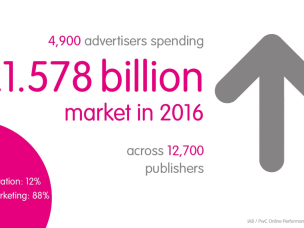Why YouTube Is an Essential Part of Affiliate Marketing
Written by Emma Sharp on 14 minute read
Statistics show that YouTube may be the most undervalued tool when it comes to affiliate marketing.

In today's digital marketing landscape, affiliate marketing stands out as a highly effective strategy for businesses. This approach has been gaining significant momentum over the years, especially with the advent of influencer marketing. In affiliate marketing, a company pays people or websites (affiliates) to promote its products or services. The affiliates use platforms like social media or blogs for advertising. When their promotion leads to a sale or website visit, they earn a commission. This strategy benefits the company with more sales and exposure, and affiliates earn money for their promotional efforts.
Affiliate marketing is now responsible for 15-30% of eCommerce sales, and affiliate marketing on YouTube is one of the most successful ways to earn extra money for your business. With a global audience of 2.53 billion all in one place, YouTube ranks as the world’s second-most popular social media site. By 2025, it is estimated that YouTube will have 1 billion users worldwide. In fact, YouTube users are increasingly comfortable with affiliate marketing links in videos, as they often visit the site for advice or research, making the 'selling' aspect less intrusive.
Is affiliate marketing allowed on YouTube?
Yes, affiliate marketing and link tracking using YouTube is allowed and one of the best ways to make money from the platform. For example, content creators can add their affiliate links to the description box underneath their video, or in the annotations of the video itself. Success in YouTube affiliate marketing requires not just creating engaging content, but also building a dedicated subscriber base to drive views and purchases from affiliate links.
When using affiliate marketing on YouTube, affiliate links must be disclosed in the video description, not included in the video itself or its title. Content should be honest, relevant to the video, and not solely for earning commissions. Affiliates should promote only products they've used or believe in, avoiding items that are illegal, dangerous, or against YouTube's community guidelines and terms of service.
How to add affiliate links to a standard YouTube video
Here are a couple of ways to try out YouTube affiliate marketing:
Description
Your links should be available in the detailed video description below the video itself. This way video viewers and potential buyers can quickly find the link without having to watch the whole video again.
Start by joining affiliate marketing programmes from sites like Awin. Once approved, incorporate these links into your YouTube video descriptions. Use link shorteners like Bitly to make your affiliate links more visually appealing. Enhance these links with compelling Call-to-Actions (CTAs) to encourage viewer engagement and increase positive responses. Remember, simply adding links isn't enough; creating context and motivation for your audience is key.
Comments
Commenting on other popular content with your links has become a prominent strategy with some affiliate marketers, though should be used with discretion. By finding other creators’ content and reading viewers’ comments and questions, you may find some that are suitable to reply to with your affiliate links. These comments can be as simple as ‘I agree with xxx, these are great suggestions. I also recommend this product xxx it’s worked well for me’. It’s best to only do this if you believe you are adding value to the conversation. There are certain bots and tools available that skim YouTube to post these comments automatically on videos it deems related to a keyword or topic; however, as always, we would recommend avoiding using automated tools in this way, as the AI is not always accurate and YouTube could see it as spam content and penalise your account.
YouTube cards
YouTube cards are graphic elements which appear in videos and offer a more visually appealing alternative to the discontinued text-based annotations. YouTube cards pop up when viewers click the small “i” button on the video. YouTube cards are designed to be as unobtrusive as possible, so the cards (thumbnail and link) only become visible through viewer interaction. Their design optimises the user experience, smoothly guiding viewers to affiliate links, especially on mobile devices, which have become the primary way people view YouTube videos.
Adding YouTube Cards:
- Go to "Video Manager," then click "Edit" under the chosen video.
- Select "Cards" and click "Add Card" to choose your card type.
- Fill in the required information, set the timeline for the card, and apply changes.
End screen
By using the end screen at the end of videos, you can direct viewers to other channels, playlists, and videos, and promote crowdfunding campaigns, merchandise, and websites. To add an end screen, your video should be at least 25 seconds long. The end screen allows elements like video playlists for user engagement, a subscribe option for easy channel subscriptions, channel promotion, and direct links to websites. However, to add external links, you must have an Adsense account and enable monetisation.
Adding a YouTube End Screen:
- In Creator Studio, go to Video Manager.
- Select the video you want to add the end screen to.
- Choose 'End Screen & Annotations' at the top.
- Add or configure elements, such as suggested playlists/videos, subscription prompts, channel promotions, and website links.
- Customise the appearance and check how it will display to viewers.
Can you add affiliate links in YouTube Shorts?
Unfortunately, you can’t add affiliate links in YouTube Shorts. As of August 31st 2023, links added in the descriptions and comments of YouTube Shorts content became unclickable. Due to issues with spam links sending users to dangerous content like malware and phishing scams, YouTube decided to remove links altogether.
Benefits of using YouTube for affiliate marketing

1. You don’t have to register with another affiliate programme
Using YouTube as an affiliate marketer is simple, as you don’t have to register with YouTube’s programme to begin creating video content and inserting your affiliate links within it. Just upload your video to the creator studio and begin optimising your content! By SEO-optimising your videos, you can boost visibility on search engine results pages (SERPs), thereby increasing traffic.
Videos are the most commonly shared type of content, which means they have immense power when it comes to monetising your YouTube channel through passive income. In fact, 68% of users watch YouTube videos to aid in their purchasing decisions. For example, adding affiliate links in content like how-to videos helps to effectively connect YouTube users with useful, featured products.
2. It’s the 2nd most-visited website worldwide
Interestingly, YouTube is the only other site which can compete with Google for total worldwide visits. Every month, YouTube has 117.3 billion visits and it is the second most popular social network in the world. With a global audience of billions using YouTube to consume and engage with content, it’s the perfect platform for affiliate marketing to thrive. While trying to rank on page one of Google is sometimes a difficult SEO battle, ranking within YouTube can be far easier. Some simple optimisation techniques can help increase your organic views.
3. Optimising YouTube content is easy
Though over 500 hours of video content are uploaded to YouTube every minute, the opportunity to cut through the clutter is still available to anyone willing to put in a little extra effort.
Optimising YouTube videos is currently quite simple. Beyond simply tagging up the metadata of your videos correctly, there are a few main ways to optimise your video content on YouTube for efficient affiliate marketing.
- Do your keyword research
Just as when creating SEO-focused content for your website or blog, a similar keyword strategy can be used for YouTube. Figure out what videos other creators have uploaded around your targeted topic or product. Watch the main videos that appear and ask yourself if they have missed anything that you can cover further in your content or if there is something that you could explain better.
Ensure you use your main keyword in the title of your video. Then use it and other related keywords in the tags of your video, throughout the script used in the actual video content and within the first sentence of your video description.
- Write a detailed description of your video
Treat the video description like a mini-blog. 250-500 words is an ideal length. This is less for the benefit of the viewers and more for both YouTube and Google to understand (and rank) the video content. Using your keywords repeatedly, though not unnaturally, throughout the video description will assist in this.
- Transcribe
Use your keywords repeatedly throughout your video, then transcribe it. Transcribing your videos seems like a needless effort, but as many content creators choose to avoid this extra step, doing so actually makes your videos stand out. This is a great opportunity to help YouTube further grasp your content and increase the recognition of your keywords.
- Interlink between your content
Once the ball is rolling and you have several videos with affiliate links on your YouTube channel, you can connect the videos to increase views on them all. The main way to do this is to create playlists with connected themes.
4. Recommendations and advice are YouTube’s biggest draws
What works well on YouTube is also what works well for affiliate marketing - advice and recommendations.
The most successful types of video categories on YouTube are tutorials and how-to’s, ‘top’ lists and product reviews. All three of these content types are perfect for inserting affiliate links into and proving that users are already looking for advice and purchasing suggestions.
Studies have shown that 68% of YouTube users watched a video to help them make a purchase decision, and of those, 80% said they watched the video at the beginning of the shopping process. So, users are here, they’re looking for answers and they’re happy to spend.
Building your video concept around your affiliate links should be simple when you know users are already seeking advice.
5. Trust has already been built
It’s long been proven that people are far more likely to purchase from a company they trust.
Fortunately, if you have already built up a dedicated following on YouTube, your audience probably already trusts you or feels some kind of connection to you.
Inserting affiliate links into your content and recommending products you believe to your subscribers is a logical progression and one that hopefully your video viewers will feel comfortable with. If you have built trust with your audience, they are far more likely to purchase what you are suggesting.
If you are just starting your account, it may be best to wait to begin inserting affiliate links within your own content until you have built some level of trust with your audience, or whoever you choose to collaborate with. Though this is certainly not a rule, people are likely to purchase from someone they feel a rapport or understanding with.
6. You don’t need big production budgets
One of the many beautiful things about YouTube is that the content doesn’t always have to be polished. Of course, there are visual benefits to beautiful lighting, microphones and a studio setting, but with the right content that others are looking for, a simple video taken on a phone can still rank alongside network giants with large budgets.
Read more about how to harness the power of affiliate marketing as a small business >
What niches are best for YouTube affiliate marketing?
It’s a big wide world (web) out there and it is filled with content. Choosing a particular niche that isn’t well explored on YouTube is a great way to help your video, and therefore your affiliate links, stand out from the crowd.
As a publisher, if the product or service you are an affiliate for has already been well covered, experiment with ways to niche down your video around a specific topic, answer very precise questions around it, or touch on other associated but perhaps not directly related content. Remember that each niche has its own unique audience and profit potential. A few popular and profitable niches might include:
Gadgets & Tech
Tech purchases are often a big investment, so there’s a huge audience out there interested in making informed purchases. Use unboxings, reviews and how-to guides to insert relevant affiliate links.
Gaming
Gaming videos have been skyrocketing in popularity since 2020, with e-sports becoming an in-demand spectator sport. Game playthroughs, reviews, and gaming equipment showcases cater to a passionate and competitive audience, always looking for the best equipment.
Fashion & Beauty
Tutorials, product reviews, and fashion advice videos are hugely popular, as viewers often seek recommendations from trusted influencers before buying. In fact, 39% of consumers said influencers had some impact on their purchasing decisions online.
Health & Fitness
In recent years, consumers have become increasingly concerned about wellness. More than two-thirds of consumers are focusing on their health more than before. YouTube channels which offer workout routines, nutritional advice (like healthy recipe content) and reviews of health products often see high levels of engagement.
Can you do effective affiliate marketing without YouTube?
Conducting market research is vital to finding new niches for your YouTube affiliate marketing. Several approaches can guide your search, like analysing social media and using tools like Google Trends to pay attention to your audience’s needs and interests. Be solution-oriented. What are the answers they’re looking for in their search? As an expert in your industry, leverage personal passions and knowledge to create content which genuinely resonates with your audience. Plus, keep up to date with what your competitors are doing and if there are any content gaps you could fill.
When it comes to alternative ways to use affiliate marketing, then it’s hard to ignore Facebook - the most popular social media network in the world with 3 billion active monthly users. Choosing between Facebook and YouTube for affiliate marketing depends mainly on your target audience, niche and the marketing goals you have for your business.
- For niches which benefit from in-depth visual content like tech reviews or makeup tutorials, YouTube is better to supply longer-form videos for comprehensive information and demonstrations for educational content.
- Facebook, on the other hand, is more effective for niches which thrive on community interaction and quick, live updates. On Facebook, short-form content is better received and reaches a broad demographic which relies on shareability within communities and groups.
Keep your marketing goals in mind too. For instance, if you’re aiming for deep engagement and building a loyal base of subscribers, YouTube is the right choice. If you’re looking for quick reach and shareability within a community, opt for Facebook.
Above all, success hinges on creating genuine, engaging content that provides value and seamlessly incorporates affiliate products tailored to your viewers' interests and needs.
Find out more about affiliate marketing strategy and tips here, and get more from your affiliate marketing with the experts at Awin.



